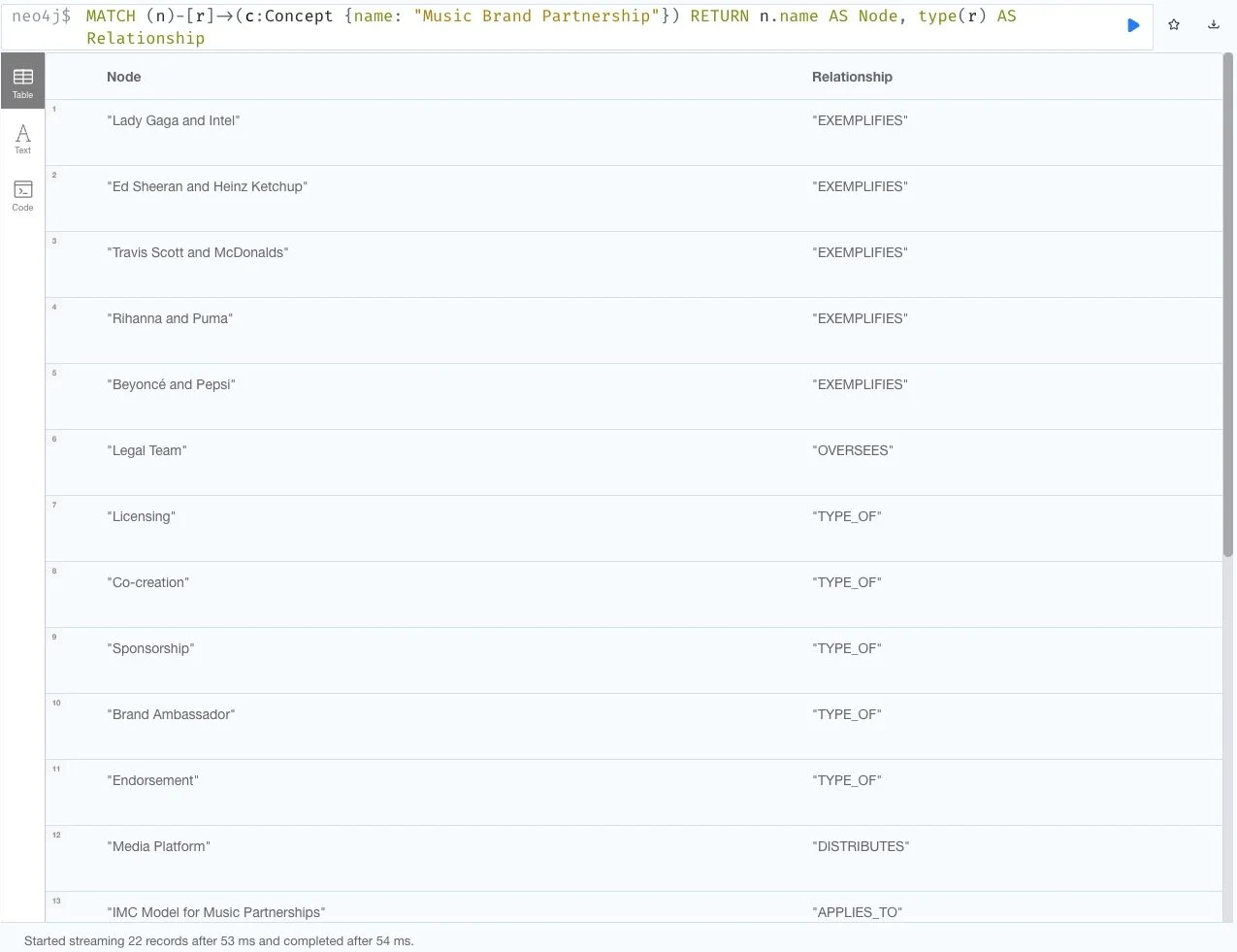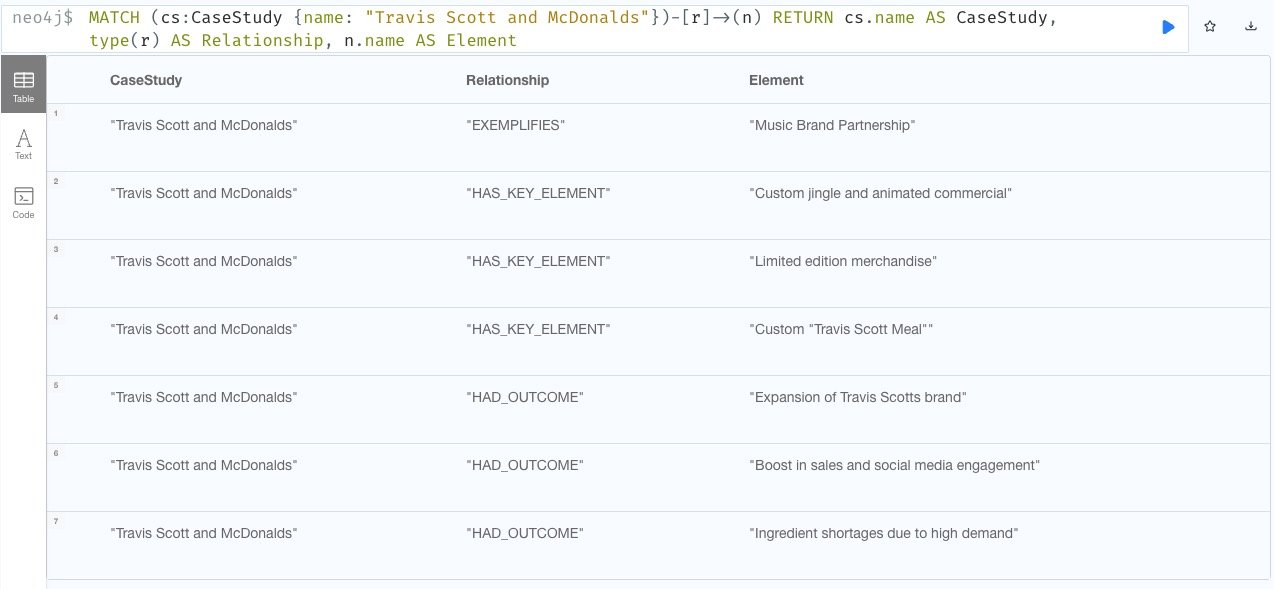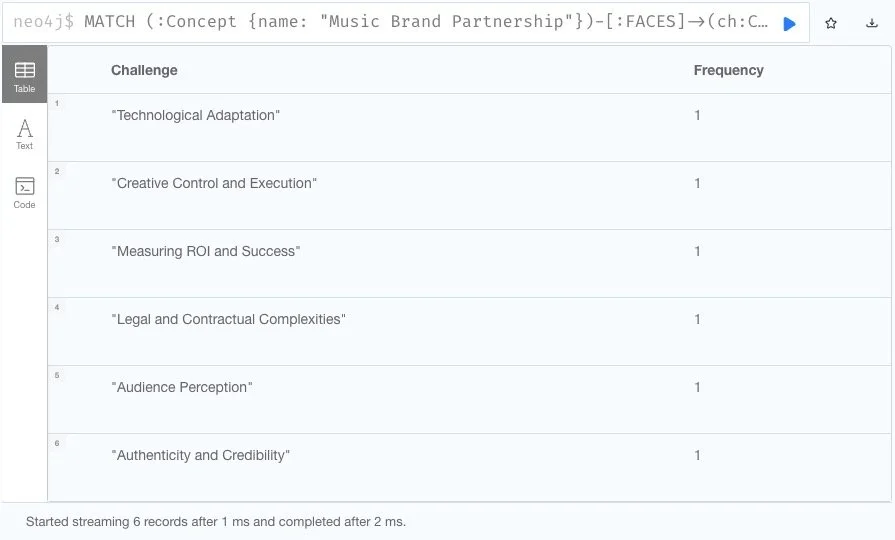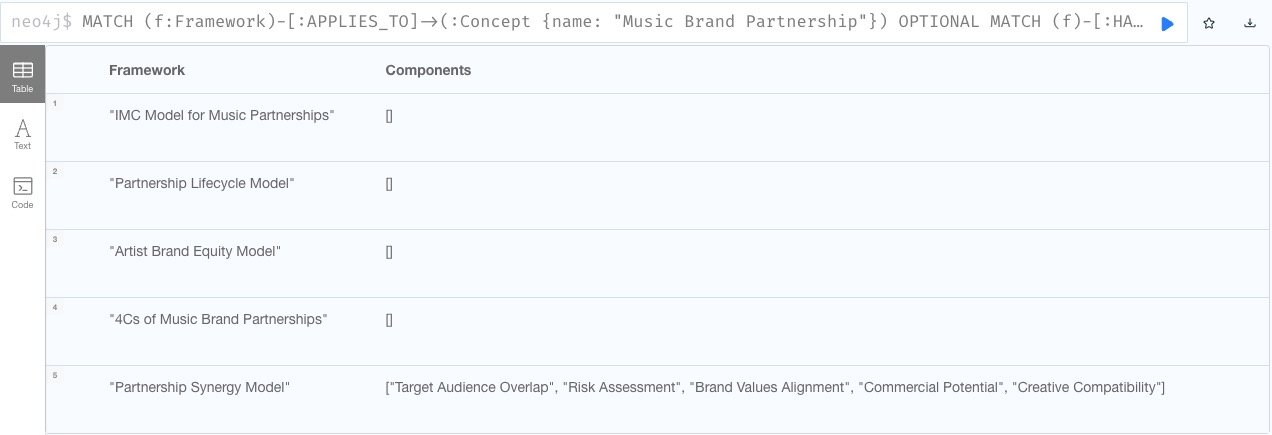A Knowledge Graph of Music Brand Partnerships with Neo4j
On This Page
- Introduction
- Mapping Music Brand Partnerships to the Graph
- What Is A Knowledge Graph?
- Query 1: The Full Monty
- Query 2: The Web of Collaboration
- Query 3: The Partnership Universe
- Query 4: Six Degrees of Brand Partnerships
- Query 5: Case Study Deep Dive
- Query 7: Benefits
- Query 8: Common Challenges
- Query 9: Frameworks
- Conclusion
Explore a unique knowledge graph with me.
IntermediateSummary
In this post, you'll recreate my graph on music brand partnerships and learn how to use Neo4j and Cypher queries to explore the knowledge within it.
Target Audience
This article is suitable for intermediate AI explorers.
Key Takeaways
- Visualize the complex ecosystem of music brand partnerships.
- Pick up some practical Neo4j and Cypher query techniques.
- Uncover insights from real-world partnership case studies.
Introduction
Music brand partnerships are one of the most powerful ways for brands to tap into culture and win affinity with their target consumers.
Don’t believe me?
This summer, a brand collaboration between Coca-Cola and Karol G became the #1 music video on YouTube for weeks, reaching ~300M YouTube views, charting globally, and placing the brand front-and-center with Karol’s massive global fanbase across web, social, and streaming platforms.
This was the work of Coke Studio, a global brand partnership program that I lead at Universal Music Group for Brands.
Now, this kind of success is hard-won. It’s not the norm, and achieving it requires a deep understanding of the big picture and a keen eye for the details.
In fact, it’s like a symphony – many different entities, processes, and external factors working together to produce the kind of alchemy that shapes culture.
Yes, the ecosystem of music-brand partnerships is complex.
And that makes it fascinating to model as a knowledge graph.
Mapping Music Brand Partnerships to the Graph
In particular, these global partnerships span a wide range of entities and data points that are richly connected through integrated relationships.
Artists, brands, fans, trends, media assets, operating units, social channels, and much more.
Nearly everything is connected in one way or another, and there is a tidal wave of data, data, data.
While my current role at UMGB has seen my focus shift from enterprise innovation to brand partnerships, I’ve found myself enjoying the challenge of knowledge management in such a dynamic ecosystem.
Thus, I found myself recently mapping my Domain Knowledge Compendium of Music Brand Partnerships into a knowledge graph format using Neo4j.
(A domain knowledge compendium or DKC is one of several unique formats I’ve created for structuring knowledge as a human-friendly yet machine-readable context injection to utilize in work with LLMs).
Want my prompt for Automated DKC Creation?
Use this pre-built resource to transform complex information into clear structured knowledge.
Grab it hereWhat Is A Knowledge Graph?
If you’re not familiar with knowledge graphs, they are a powerful multi-dimensional tool for structuring interconnected data systems.
Neo4j’s GraphAcademy is a worthwhile starting point for more technical learners.
Understanding Knowledge Graphs
Knowledge graphs are structured representations of data that connect entities and concepts, enabling complex querying and inference of relationships within the information.
When combined with large language models, these graphs prove particularly useful for equipping an AI assistant with a well structured ‘source of truth’ when generating responses.
GraphRAG (short for Graph Retrieval Augmented Generation) is one such approach.
In this post, I’m giving you the Cypher code to populate your own Neo4j graph database with the insights from my informal DKC.
Cypher is Neo4j’s query language, allowing you to interact with the graph you’ve created,
I’m also going to give you a handful of Cypher queries that you can use to explore different ways to ‘slice the data’ in a knowledge graph. This is how you can find insights using a graph-based approach that might be otherwise difficult to uncover in a traditional database.
As a first step, you should probably download Neo4j Desktop. 😇
It’s free!
Once you’ve done that, start Neo4j Desktop, copy the Cypher query below, paste it into the top cell of your database (1) and run it (2).
Once that's done, let's dive into some interesting queries that will help you navigate this intricate web of partnerships, stakeholders, and outcomes!
// Create Category nodes
CREATE (:Category {name:"Endorsement"}),
(:Category {name:"Sponsorship"}),
(:Category {name:"Co-creation"}),
(:Category {name:"Brand Ambassador"}),
(:Category {name:"Licensing"});
// Create Concept node
CREATE (:Concept {name:"Music Brand Partnership", definition:"A strategic collaboration between a music artist or entity and a commercial brand"});
// Create Role nodes
CREATE (:Role {name:"Artist"}),
(:Role {name:"Brand"}),
(:Role {name:"Record Label"}),
(:Role {name:"Talent Agency"}),
(:Role {name:"Legal Team"}),
(:Role {name:"Media Platform"}),
(:Role {name:"Fan"});
// Create CaseStudy nodes
CREATE (:CaseStudy {year:2012, name:"Beyoncé and Pepsi"}),
(:CaseStudy {year:2020, name:"Travis Scott and McDonalds"}),
(:CaseStudy {year:2016, name:"Lady Gaga and Intel"}),
(:CaseStudy {year:2014, name:"Rihanna and Puma"}),
(:CaseStudy {year:2019, name:"Ed Sheeran and Heinz Ketchup"});
// Create KeyElement nodes
CREATE (:KeyElement {name:"Custom \"Travis Scott Meal\""}),
(:KeyElement {name:"Limited edition merchandise"}),
(:KeyElement {name:"Custom jingle and animated commercial"}),
(:KeyElement {name:"Pepsi cans featuring Beyoncés image"}),
(:KeyElement {name:"Sponsorship of world tour"}),
(:KeyElement {name:"$50 million creative project fund"});
// Create Outcome nodes
CREATE (:Outcome {name:"Ingredient shortages due to high demand"}),
(:Outcome {name:"Boost in sales and social media engagement"}),
(:Outcome {name:"Expansion of Travis Scotts brand"}),
(:Outcome {name:"Increased brand visibility"}),
(:Outcome {name:"Funding for artistic endeavors"}),
(:Outcome {name:"Criticism for promoting sugary drinks"});
// Create Benefit nodes
CREATE (:Benefit {name:"Financial Benefits"}),
(:Benefit {name:"Expanded Reach"}),
(:Benefit {name:"Creative Opportunities"}),
(:Benefit {name:"Career Longevity"}),
(:Benefit {name:"Enhanced Brand Image"}),
(:Benefit {name:"Targeted Marketing"}),
(:Benefit {name:"Content Creation"}),
(:Benefit {name:"Product Development"});
// Create Challenge nodes
CREATE (:Challenge {name:"Authenticity and Credibility"}),
(:Challenge {name:"Audience Perception"}),
(:Challenge {name:"Legal and Contractual Complexities"}),
(:Challenge {name:"Measuring ROI and Success"}),
(:Challenge {name:"Creative Control and Execution"}),
(:Challenge {name:"Technological Adaptation"});
// Create Framework nodes
CREATE (:Framework {name:"Partnership Synergy Model"}),
(:Framework {name:"4Cs of Music Brand Partnerships"}),
(:Framework {name:"Artist Brand Equity Model"}),
(:Framework {name:"Partnership Lifecycle Model"}),
(:Framework {name:"IMC Model for Music Partnerships"});
// Create Responsibility nodes
CREATE (:Responsibility {name:"Maintain artistic integrity"}),
(:Responsibility {name:"Engage with fans"}),
(:Responsibility {name:"Collaborate on product design"});
// Create Component nodes
CREATE (:Component {name:"Brand Values Alignment"}),
(:Component {name:"Target Audience Overlap"}),
(:Component {name:"Creative Compatibility"}),
(:Component {name:"Commercial Potential"}),
(:Component {name:"Risk Assessment"});
// Create relationships
MATCH (rl:Role {name:"Record Label"})
WITH rl
MATCH (c:Concept {name:"Music Brand Partnership"})
CREATE (rl)-[:FACILITATES]->(c);
MATCH (ta:Role {name:"Talent Agency"})
WITH ta
MATCH (c:Concept {name:"Music Brand Partnership"})
CREATE (ta)-[:NEGOTIATES]->(c);
MATCH (c:Concept {name:"Music Brand Partnership"})
WITH c
MATCH (ch:Challenge)
CREATE (c)-[:FACES]->(ch);
MATCH (f:Role {name:"Fan"})
WITH f
MATCH (c:Concept {name:"Music Brand Partnership"})
CREATE (f)-[:ENGAGES_WITH]->(c);
MATCH (r:Role)
WHERE r.name IN ["Artist", "Brand"]
WITH r
MATCH (c:Concept {name:"Music Brand Partnership"})
CREATE (r)-[:PARTICIPATES_IN]->(c);
MATCH (a:Role {name:"Artist"})
WITH a
MATCH (r:Responsibility)
CREATE (a)-[:HAS_RESPONSIBILITY]->(r);
MATCH (f:Framework)
WITH f
MATCH (c:Concept {name:"Music Brand Partnership"})
CREATE (f)-[:APPLIES_TO]->(c);
MATCH (cs:CaseStudy {name:"Travis Scott and McDonalds"})
WITH cs
MATCH (o:Outcome)
WHERE o.name IN ["Ingredient shortages due to high demand", "Boost in sales and social media engagement", "Expansion of Travis Scotts brand"]
CREATE (cs)-[:HAD_OUTCOME]->(o);
MATCH (cs:CaseStudy {name:"Beyoncé and Pepsi"})
WITH cs
MATCH (o:Outcome)
WHERE o.name IN ["Increased brand visibility", "Funding for artistic endeavors", "Criticism for promoting sugary drinks"]
CREATE (cs)-[:HAD_OUTCOME]->(o);
MATCH (cs:CaseStudy {name:"Travis Scott and McDonalds"})
WITH cs
MATCH (ke:KeyElement)
WHERE ke.name IN ["Custom \"Travis Scott Meal\"", "Limited edition merchandise", "Custom jingle and animated commercial"]
CREATE (cs)-[:HAS_KEY_ELEMENT]->(ke);
MATCH (cs:CaseStudy {name:"Beyoncé and Pepsi"})
WITH cs
MATCH (ke:KeyElement)
WHERE ke.name IN ["Pepsi cans featuring Beyoncés image", "Sponsorship of world tour", "$50 million creative project fund"]
CREATE (cs)-[:HAS_KEY_ELEMENT]->(ke);
MATCH (mp:Role {name:"Media Platform"})
WITH mp
MATCH (c:Concept {name:"Music Brand Partnership"})
CREATE (mp)-[:DISTRIBUTES]->(c);
MATCH (cat:Category)
WITH cat
MATCH (c:Concept {name:"Music Brand Partnership"})
CREATE (cat)-[:TYPE_OF]->(c);
MATCH (lt:Role {name:"Legal Team"})
WITH lt
MATCH (c:Concept {name:"Music Brand Partnership"})
CREATE (lt)-[:OVERSEES]->(c);
MATCH (f:Framework {name:"Partnership Synergy Model"})
WITH f
MATCH (comp:Component)
CREATE (f)-[:HAS_COMPONENT]->(comp);
MATCH (a:Role {name:"Artist"}), (b:Role {name:"Brand"})
CREATE (a)-[:COLLABORATES_WITH]->(b),
(b)-[:COLLABORATES_WITH]->(a);
MATCH (cs:CaseStudy)
WITH cs
MATCH (c:Concept {name:"Music Brand Partnership"})
CREATE (cs)-[:EXEMPLIFIES]->(c);
MATCH (r:Role {name:"Artist"})
WITH r
MATCH (b:Benefit)
WHERE b.name IN ["Financial Benefits", "Expanded Reach", "Creative Opportunities", "Career Longevity"]
CREATE (r)-[:GAINS]->(b);
MATCH (r:Role {name:"Brand"})
WITH r
MATCH (b:Benefit)
WHERE b.name IN ["Enhanced Brand Image", "Targeted Marketing", "Content Creation", "Product Development"]
CREATE (r)-[:GAINS]->(b);
Query 1: The Full Monty
First things first, let’s take a look at this beauty of a graph.
Use the Cypher query below to see all of the nodes and relationships in the graph.
MATCH (n) OPTIONAL MATCH (n)-[r]->(m) RETURN n, r, m
This is our master view of the graph. Here we can see the big picture.
The central / master node of this whole thing is Music Brand Partnership:
Everything ultimately maps back to this central point of the graph.
To get a bit more granular, we’ll use Cypher queries to explore different focal points in the graph.
Query 2: The Web of Collaboration
So we’ve got artists and brands in this hypothetical partnership.
Let's visualize how Artists and Brands collaborate:
This query shows the mutual collaboration between Artists and Brands.
This one is rather self-explanatory, but it underpins the entirety of the partnership ecosystem. And yes, there can be multiple artists or brands. This snapshot simply shows us the relationship between all artists and brands in our partnership – COLLABORATES_WITH.
Theoretically, we could also create the same relationship between two artists if they were doing a collaborative track for the partnership.
Query 3: The Partnership Universe
Let's get an overview of our knowledge graph. This query will show us all the different types of nodes we have:
MATCH (n) RETURN DISTINCT labels(n) AS NodeTypes, COUNT(*) AS Count ORDER BY Count DESC
Now we have a bird's-eye view of our knowledge graph, showing all the different types of entities we're dealing with and how many of each type we have.
You’ll notice that from this query a table is returned, not a snapshot of the graph with all of our colored nodes and lines.
The ability to view data in different dimensions is a hallmark of working with a graph database. We can slice our data in many different ways to uncover insights. It’s not only a table or only a graph visualization or only code. It’s all of these at once in many cases, but we use our discretion to decide which usage is most beneficial for our purposes.
Query 4: Six Degrees of Brand Partnerships
Now, let's see how everything is connected to our central concept of Music Brand Partnerships:
MATCH (n)-[r]->(c:Concept {name: "Music Brand Partnership"}) RETURN n.name AS Node, type(r) AS Relationship
This query will show you all the nodes directly connected to the "Music Brand Partnership" concept we highlighted at the top of this post and how they're related.
It's like playing "Six Degrees of Kevin Bacon," but with brand partnerships.
Query 5: Case Study Deep Dive
Time to put on your analyst hat!
Let's look at a specific case study and see all its elements:
MATCH (cs:CaseStudy {name: "Travis Scott and McDonalds"})-[r]->(n) RETURN cs.name AS CaseStudy, type(r) AS Relationship, n.name AS Element
This query will give you a comprehensive view of the Travis Scott and McDonald's partnership, showing all its key elements and outcomes.
You can always add further layers of intricacy to this ecosystem, digging deeper into nodes such as “Boost in sales” to tie this to actual data points.
In this case I’ve tried to strike a balance between intricacy and accessibility so you can get the gist of knowledge graphs in this context.
Query 7: Benefits
Let's see who's gaining what from these partnerships:
MATCH (r:Role)-[:GAINS]->(b:Benefit) RETURN r.name AS Stakeholder, collect(b.name) AS Benefits
This query shows you all the benefits that different stakeholders gain from music brand partnerships.
Similarly to Query 6, the level of detail you build into your graph is up to you. If you wanted to fill these benefits out with more specifics, you certainly could.
For example, what does "Financial Benefits” entail? How about “Enhanced Brand Image”?
These are quantifiable aspects of a partnership (e.g. revenue driven, increased brand affinity, etc.) and you should reasonably have specific data points to associate with these nodes on the graph.
For now, we’re keeping it simple in this demo but I encourage you to consider expanding a graph for your own purposes to see what you can do with it.
Query 8: Common Challenges
Which challenges are common in music brand partnerships?
Let's find out:
MATCH (:Concept {name: "Music Brand Partnership"})-[:FACES]->(ch:Challenge) RETURN ch.name AS Challenge, count(*) AS Frequency ORDER BY Frequency DESC
This query ranks the challenges faced in music brand partnerships.
Query 9: Frameworks
Let's explore the frameworks used in music brand partnerships:
MATCH (f:Framework)-[:APPLIES_TO]->(:Concept {name: "Music Brand Partnership"}) OPTIONAL MATCH (f)-[:HAS_COMPONENT]->(c:Component) RETURN f.name AS Framework, collect(c.name) AS Components
This query shows you the frameworks used in music brand partnerships and their components (if any). It's like getting a peek at the blueprint of successful collaborations!
I linked my music brand partnership DKC at the top of this article, but it’s worth noting that this example is non-exhaustive and has been populated in collaboration with AI.
There are MANY frameworks that you could integrate here. You’ll see that Partnership Synergy Model is the only one that has any additional components at present.
In a more complete graph of this ecosystem, we would have many more additional layers to accompany the Frameworks category as well as other categories.
Conclusion
These queries are just the beginning of your journey through the Music-Brand Partnerships knowledge graph.
Feel free to modify them, combine them, or create your own to uncover even more insights.
You can also paste the main Cypher query from the beginning into your conversation with an AI chatbot to expand it, find new queries, etc.
Remember, in the world of graph databases, connections are everything – so don't be afraid to explore those relationships!
Happy querying, and may you unlock the secrets of music brand partnerships along the way!









